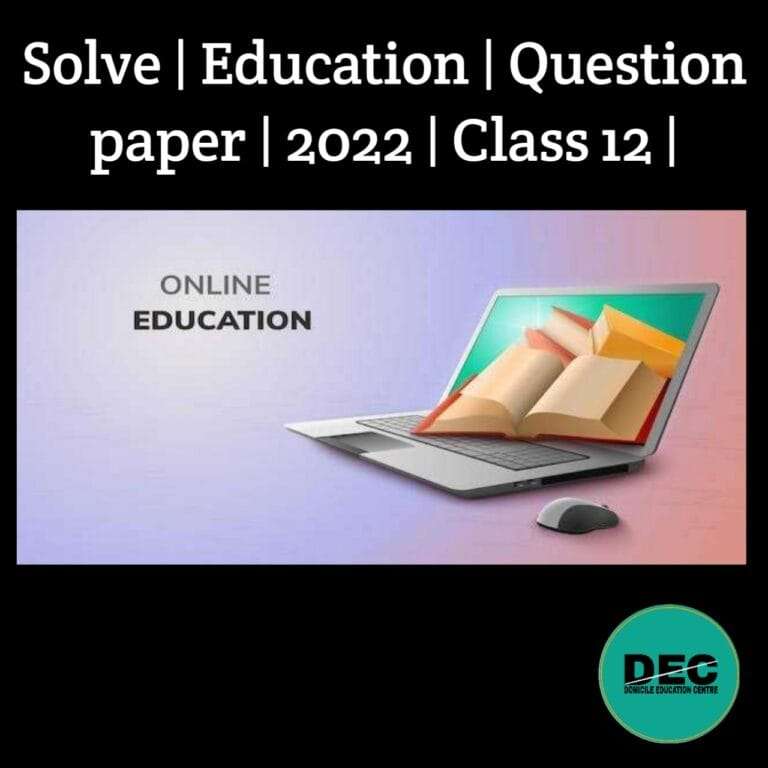Table of Contents
ToggleSolve | Education | Question Paper | 2022 | Class-12 |
Solve Education Paper 2022
Here You will get Solution of Education Paper 2022 for Class 12.
2022
EDUCATION
Full marks: 100
Pass marks: 30
Time: Three hours
The figures in the margin indicate full marks for the questions.
- No. 1 carries 1 marks each …………………. 1 x 12 = 12
- No. 2 carries 2 marks each …………………. 2 x 12 = 24
- No. 3 carries 4 marks each …………………. 4 x 10 = 40
- No. 4 carries 6 marks each …………………. 6 x 4 = 24
Total = 100
1.Answer the following questions: (any twelve) 1 x 12 = 12
Fill in the Blanks:
(a) Gauhati University was established in ___________ .
Ans: 1948
(b) In the year ___________ the Correspondence Education System was started in India.
Ans: 1962
(c) The World Environment Day is observed on ____________ .
Ans: Every year 5th June.
(d) Edward Lee Thorndike’s Trial and Error method of learning is also known as Theory of __________________ .
Ans: Connectionism.
(e) In a multiple choice question, a student can identify the correct answer with the help of ____________ process.
Ans: Recognition.
(f) All scores are taken into consideration in finding out __________ as measure of Central Tendency.
Ans: Mean
Give Short Answer in one sentence :
(g) What is Distance Education ?
Ans: Distance Education is nothing but it is a system of providing education which is imparted to students through mass media, correspondence courses and other audio-visual materials from a distance who are unable to attend classroom lecture and wished to enhance their qualification is known as Distance Education.
(h) “Learning is the acquisition of new behaviour or the strengthening and weakening of old behaviour as a result of experience.” Who said this statement ?
Ans: According to Smith.
(i) Who was the propounder of Classical Conditioning Theory of learning ?
Ans: Ivan Pavlov
(j) “Memory is the ideal revival…… in which the object of past experiences are reinstated as far as possible in the order and manner of their original occurrence.” Who said this ?
Ans: According to Stout.
(k) What is volitional or voluntary attention ?
Ans: When an individual is physically and mentally ready to pay attention and he does it out of his own will, is called Voluntary or Volitional attention.
(l) Write the formula for finding out Median from group data.
Ans: Let check Here in details.
2. Write two aims of Secondary Education recommended by Mudaliar Commission. 2
Ans: The two aims of Secondary Education recommended by Mudaliar Commission are:
i. Development of Personality:
As we know that man is a social animal, So he should have the spirit of cooperation, discipline, humility, love, kindness and the feeling of brotherhood. So, for the development of personality, the curriculum must have the subjects like – science, literature, fine arts, humanities, music and dace which inculcate these virtues in students.
ii. Education for Leadership:
Secondary Education should develop the quality of leadership in students. This quality is very necessary for the sake of democracy and for the development of the country as a whole in various fields of life, namely – social, cultural, political, industrial, etc.
3. Write two suggestions of Kothari Commission regarding education and productivity. 2
Ans: The two suggestions of Kothari Commission regarding ‘Education and Productivity’ are mentioned below:
i. The Kothari Commission suggested Education should be job oriented and greater importance should be given to education in agriculture, science, industrial and technical subjects.
ii. In place of bookish knowledge, Education greater importance should be attached to the acquisition of practical knowledge and skills.
4. Write two objectives of Non-formal Education. 2
Ans: The two objectives of Non-formal Education are mentioned below:
i. To promote awareness for literacy programme for national and individual development.
ii. To establish national infrastructure needs and provide for manpower requirement.
5. Write two significant aspects of Distance Education. 2
Ans: The two significant aspects of distance education are:
(a) Learner Centric Education.
(b) Indirect Education.
6. Write two principles of Environmental Education. 2
Ans: The two principles of Environmental Education are:
i. To help social groups and individuals so as to get an awareness and sensitivity to the total environment and its allied problems.
ii. To helps social groups and individuals so as to gain a variety of experiences in and get a basis understanding of the environment and its associated problems.
7. What do you mean by Value Education ? 2
Ans: Value Education refers to the form of education that covers all aspects of personality development which endeavours the values of moral, aesthetic, intellectual, social and spiritual development for the good of the society and the individual life is called Value Education.
8. Mention two differences between maturation and learning. 2
Ans: The two difference between Maturation and Learning are mentioned below:
(a) Learning is a result of Environmental Stimulus. On the other hand, Maturation is biological in nature.
(b) Maturation occurs due to neural and muscular development. On the other hand, Learning takes place through practice and experience.
9. Write two mental causes of forgetting. 2
Ans: The mental causes of forgetting which are briefly explain in the following below:
i. Learning without interest:
Lack of interest in learning and retaining images is very important causes of forgetting in which one can easily forgets those where he has no interest.
ii. Repression:
Repression means keeping down something by force where unfulfilled desires of mind, unpleasant experience of life are voluntarily pushed back into the unconscious level of mind which may cause mental forgetting. So that repression is a kind of voluntary forgetting.
10. Mention two sources or factors that influence the interest of an individual. 2
Ans: The sources or factors that influence the interest of an individual are mentioned below:
(a) Age
(b) Intelligence
11. Mention two social qualities of a mentally healthy person. 2
Ans: The two social qualities of a mentally healthy person are:
(a) Socially well adjustment.
(b) Very confident in decision making.
12. Mention any two steps you have to follow for classifying scores into a frequency distribution table. 2
Ans: The two steps you have to follow for classifying scores into a frequency distribution table are:
i. Determination of Range:
Firstly, We should find out the range of raw scores. Range refers to the difference between the highest and the lowest scores.
ii. Class-Interval:
After finding the range, Secondly we should determined the class-interval. The class-interval depends upon the range and the number of interval required according to the range of the scores.
13. Find Mean and Median from the following the data: 1+1= 2
48, 45, 92, 56, 68, 85, 72, 74, 64, 90
Archives
14. Discuss four major problems of Secondary Education in Assam. 4
Ans: The four major problems of Secondary Education in Assam are briefly discussed below:
i. Inappropriate Curriculum:
The school curriculum is not appropriate, not related to the real and practical life to fulfil the needs of the students as well as of the society. This follow the curriculum mechanically without interest, curiosity, understanding or appreciations.
ii. Defective Text book:
The quality of text books, teachers guides and teaching materials is not satisfactory.
iii. Improper evaluation system:
The evaluation system of secondary education is not free from evil. It is basically dominated by external examination.
iv. Lack of capable teacher:
The quality of teaching stuff in schools is not satisfactory. In many of the privately managed schools the situation is dangerous.
15. Discuss four merits of Open Education System. 4
Ans: The merits and demerits of Open Education are mentioned below:
i. Admission system of the open education system is very easy and eligible criteria’s are flexible.
ii. Open Education system facilitates the people of remote areas, hilly areas, rural areas, dropouts, adult who are not entitled to get education in time.
iii. Open Education system supplied self learning material (SLM) to the learners so that it encourages the learner for self –study.
iv. Evaluation process of this system of education is continuous and comprehensive. It stressed on the self activities of the learners.
Related Post Just Click Here: Solve Education Question Paper 2023 Class-12.
Calendar of Content List:
| M | T | W | T | F | S | S |
|---|---|---|---|---|---|---|
| 1 | 2 | |||||
| 3 | 4 | 5 | 6 | 7 | 8 | 9 |
| 10 | 11 | 12 | 13 | 14 | 15 | 16 |
| 17 | 18 | 19 | 20 | 21 | 22 | 23 |
| 24 | 25 | 26 | 27 | 28 | 29 | 30 |


Recent Comments